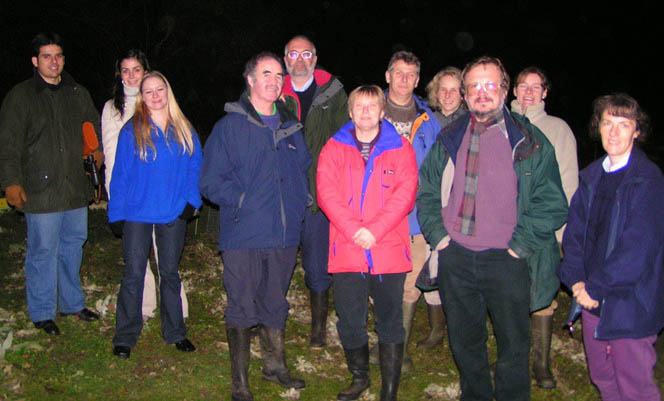
In a varied and informative session on East Anglian Ecology, David North from Norfolk Wildlife Trust (NWT) kicked-off the talks with a beautifully illustrated tour of North Norfolk which highlighted the variety of habitats we have here in Norfolk - a list that extended into double figures from the mini-desserts of the sand dunes to the salt marshes around Cley and the rich farmland providing home to 30% of the world's pink-footed geese population.
Tracking bird numbers is not an easy task and 'bird man' Mike Raven from the British Trust for Ornithology spoke about his role in the day-to-day running of this national scheme which involves overs 1800 volunteers per year. They record bird numbers at 2,250 sites nationally (of which 238 are here in the East of England). Volunteers visit 'their' 1km square 3 times a year, establishing a transect route across the square and counting breeding bird numbers. Over 200 species were counted in 2003, with the most widespread and most abundant bird being the wood pigeon. Trends have been identified for many species which are both encouraging (greta-spotted woodpecker and tree sparrow increasing about 50%) and alarming (eg. starling and tawny owl decreasing by 25-50%). The survey is allowing a picture of regional and habitat-specific variation to be established.
The first contribution from the centre for Ecology, Evolution and Conservation (CEEC) based at UEA was given by Dr Paul Dolman talking about the effects of glaciation, climate and human history in shaping the Breckland region which he described as possessing a semi-continental climate. Many sub-arctic and mediteranean species survive in Breckland despie a good deal of agricultural activity on light sandy soils. To maintain biodiversity Paul and colleagues have shown that grazing sheep is not sufficient, and (possibly surprisingly) careful ploughing regimes can help promote the heathland habitat. Possible evidence of climate change has been seen with a shift toward earlier nestings in some bird species.
After coffee, it was the turn of Dr.Diana Bell (CEEC) to speak about the pat, present and future of her 20 years of rabbit research at UEA with a wild rabbit population at the edge of the University. From an early age, rabbits are trapped and tagged allowing a detailed picture of their life to be established. Asides from observational studies, the population structure has been examined using allozymes and mini- and micro-satellite (DNA) analysis. Social groups forms within the colony with males leaving the groups and females staying together. Despite the warren being on a low-quality agricultural field the rabbits are not fed and handling is kept to an absolute minimum. Predation from urban foxes is almost as big a problem as Myxomatosis to this population. The myxomatosis virus, is believed to be carried by biting insects (rabbit fleas / harvest mites) and it is often the young that are lost. If they reach adulthood, surviving myxomatosis the adults are then immune. The probability of a rabbit recoering from myxomatosis decreases as the severity of the attack (measured on a 1-4 scale) increases.
To conclude the talks, Professor Brian Moss a former UEA lecturer, now based at the University of Liverpool, challenged that state of our freshwater ways in a talk entitled 'the art and science of freshwater restoration'. The ecological challenge he addressed was the water framework directive requiring us to achieve 'good quality' in our waterways by 2015. High-quality ecosystems are often at odds with the more limited, non-interactive view of the monitoring agencies. High-quality ecosystems require structure (plant debris and leaf litter providing animal refuges), low nitrogen levels leading to increased (invertebrate) diversity, key species, predation and competition. Newspaper reports of clean rivers should be treated with caution, as clean doesn't relfect the 'quality' of the water. English Nature (2003) described 69% of rivers and streams as unfavourable based on the levels of diffuse pollution and siltation. Such changes will mean some hard choices in the future and changes to farming and recreational practices.
In the afternoon, a series of practical activities complemented the mornings' talks. The group went sampling river life with Brian Moss and Bob James (CEEC) and examined and identified their samples upon their return to the lab. An investigation into earthworm habitats at JIC and a visit to the UEA rabbit warren rounded-off a stimulating and packed programme.

Master Class participants and rabbit experts at the UEA rabbit warren - although the end of the day approached, it wasn't this dark!
Please note, whilst every effort is made to report our speaker's talks accurately, these reports are not verbatim accounts and should not be treated as such.